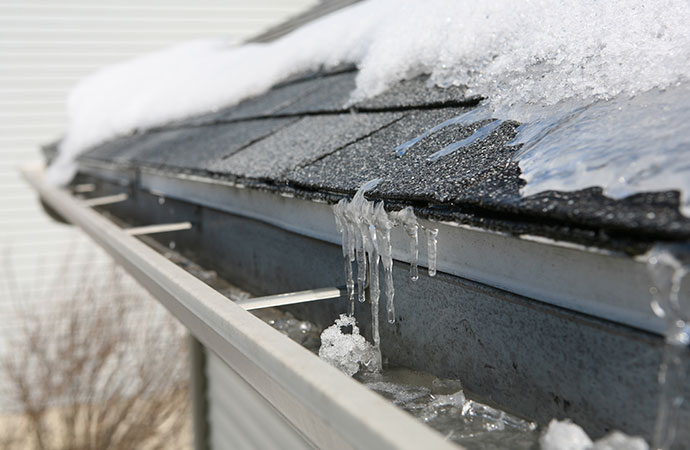Is My Roof Leaking?
Water stains may appear on your ceilings during the colder months, and the culprit may be something other than your roof.
Snow can bring unexpected challenges for homeowners. Once it begins to melt, water stains may appear on your ceilings. One immediate assumption people often make is that a leaky roof is to blame. Water stains can be caused by several factors, and the culprit isn't always overhead. Ice dams, ventilation, condensation or other issues could be the source.

What Causes Water Stains?
Finding discoloration or water marks on the ceilings can be distressing. While damaged or missing shingles, deteriorated flashing, or compromised roof materials can allow water to make its way inside, there are other winter-related reasons you may be seeing stains.
Ice dams:
An ice dam is a ridge of ice that forms along the edge of a roof — typically at the eaves or overhangs. They form from snow accumulation, fluctuating winter temperatures and heat escaping from inside the home. The presence of an ice dam prevents melted snow from properly draining off the roof. This can lead to water pooling behind the dam, potentially infiltrating the roof and causing damage to ceilings, walls, insulation and other structural components — conditions favorable for mold growth. Icicles hanging from the roof's edge can be a visible sign of an ice dam.
-
How Heartland can help:
Installing proper insulation and ventilation in the attic can help maintain a uniform roof temperature. Regular maintenance and insulation improvements can minimize the risks associated with ice dam formation. Clogged gutters can also obstruct water drainage and cause ice dams. If you think this could be the reasons for the large icicles forming on your home, Heartland can inspect your current system and make recommendations on how to improve your gutters in the future.
Condensation:
Humidity in the air is a key factor in condensation. When warm, moisture-laden air rises into the attic space, it encounters cooler surfaces and forms water droplets which can accumulate on various surfaces in the attic, including the underside of the roof deck, rafters and insulation. This is especially common during cold weather when there's a significant temperature difference between the warm indoor air and the cooler attic space.Wet insulation is less effective in retaining heat and can contribute to a cycle of condensation, especially if the attic remains inadequately ventilated. Over time, the accumulated water may start to migrate and seep into the ceiling material. It may eventually appear as water stains on the ceiling of the rooms below.
If left unaddressed, the moisture can lead to mold growth — worsening the issue with health concerns and further damage to the attic structure and ceiling.
-
How Heartland can help:
Our team can ensure your attic is well ventilated and insulated properly to allow moisture-laden air to escape. Adequate ventilation helps maintain consistent temperature levels and minimizes condensation. We can seal any gaps, cracks or leaks in the attic to prevent warm, humid air from getting in.
Poorly maintained windows:
Old or poorly maintained windows can contribute to water stains. Damaged or improperly installed window flashing, damaged wooden windowsills, poorly sealed window joints and lack of insulation can allow melting snow and other forms of water to seep through gaps and cracks. Neglecting exterior maintenance, such as cleaning gutters or addressing roof issues, can lead to water pooling around windows during heavy snowmelt, which can find its way inside.-
How Heartland can help:
As local experts in roofing, gutters and windows, our team can inspect your current windows and window flashing to find the damage and help you decide how you want to move forward. We can repair or replace damaged gutters or windows and help you upgrade to energy-efficient and well-sealed windows. Regular maintenance and timely window replacement promote a dry, well-protected and cozy home.
Overflowing gutters:
Over time, gutters can accumulate debris, forming blockages that prevent proper water drainage and lead to overflow. As water cascades down the exterior siding, it can sneak into the walls if there are cracks or gaps. Continuous exposure can result in water stains on the ceilings and — if it’s not addressed — can lead to mold growth.-
How Heartland can help:
A good place to start is an inspection with our team. If any damage or sagging is found, we can repair or replace sections or the entire system to increase proper water flow. We can also help install gutter guards to minimize debris and reduce the need to clean gutters frequently.
To accurately identify the source of water stains, start by ruling out obvious causes like plumbing leaks. If the issue persists, call us at 515-219-4847 so we can help with a thorough inspection. The specialized tools and techniques we use can pinpoint the problem, ensuring an accurate and effective solution.
Prevent Water Stains in Your Home
Preventing water stains on your ceiling involves regular maintenance and forward-thinking action. If it helps, set reminders to clean your gutters in the late spring and fall, check your roof and flashing, address plumbing issues promptly, and maintain proper ventilation throughout your home. By staying proactive, you can minimize the risk of water stains and protect your home from potential damage.
Water stains on ceilings during winter may not always signal a roof leak. Understanding the specific causes empowers you as the homeowner to take proactive steps in how you want to address the issue at hand. Schedule an inspection today to safeguard your home against the impact of these home issues and prepare you for a cozy and leak-free winter.
To learn more about our services, call 515-219-4847 or contact us online to make an appointment today in Des Moines, North Liberty and our other service area.
